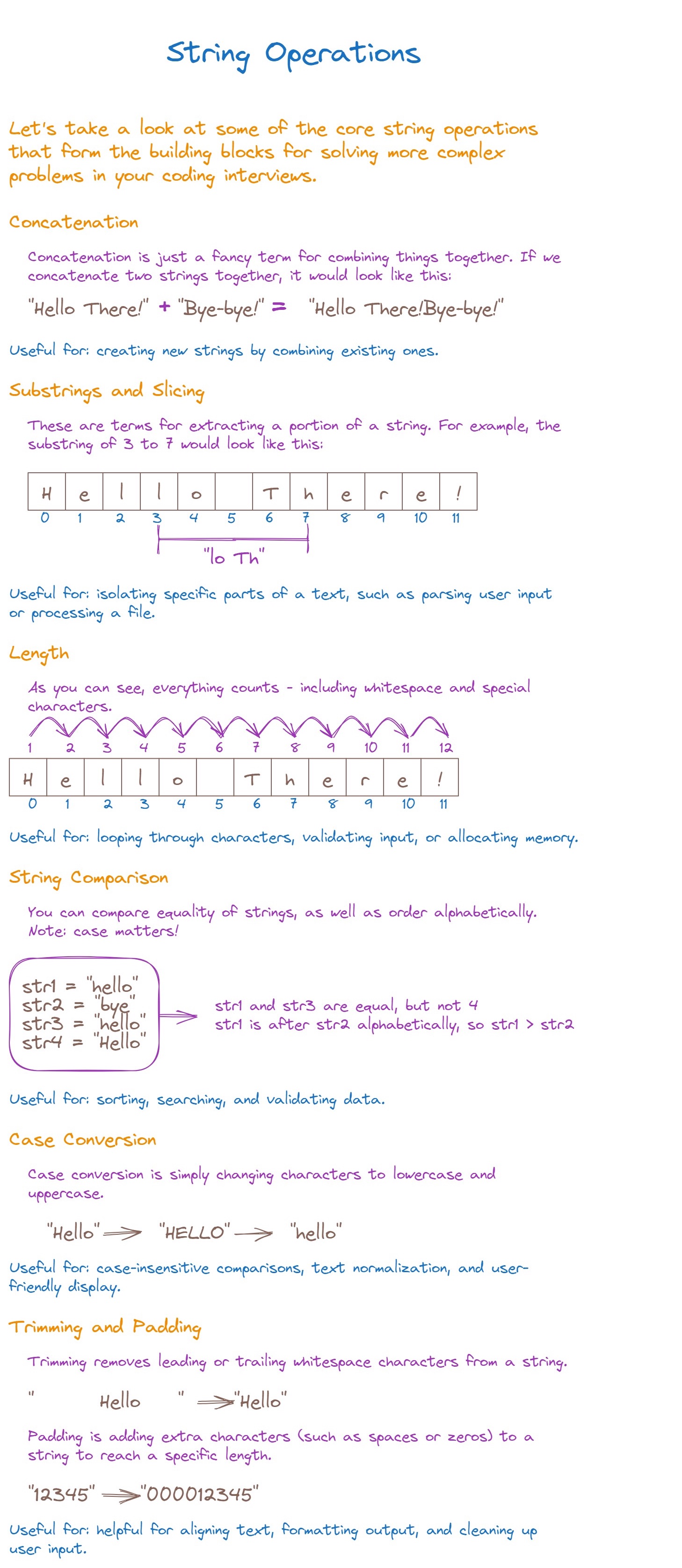In this section, we'll explore the fundamental string operations that form the core of string manipulation. These operations are widely used in programming tasks and coding interviews.

Concatenation: How to combine strings.
Concatenation refers to the operation of joining two or more strings end-to-end. It's a fundamental technique in text processing, allowing you to create new strings by combining existing ones.
1// JavaScript
2var str1 = "Hello, ";
3var str2 = "World!";
4var result = str1.concat(str2); // "Hello, World!"Substring Extraction: How to extract parts of a string.
Extracting substrings involves taking a portion of a string, defined by a starting and ending position. This is useful when you need to isolate specific parts of a text, such as parsing user input or processing a file.
1// JavaScript
2var str = "Hello, World!";
3var result = str.substring(7, 12); // "World"String Length: Finding the length of a string.
The length of a string refers to the number of characters it contains. Understanding the length is essential for tasks like looping through characters, validating input, or allocating memory.
1// JavaScript
2var str = "Hello, World!";
3var length = str.length; // 13String Comparison: Comparing strings for equality and ordering.
Comparing strings allows you to determine if two strings are equal or if one comes before or after the other in a given order (such as alphabetical). This is vital for sorting, searching, and validating data.
1// JavaScript
2var str1 = "apple";
3var str2 = "orange";
4var isEqual = str1 === str2; // false
5var isOrdered = str1 < str2; // trueCase Conversion: Changing the case of characters within a string.
Case conversion involves changing the case of characters within a string, either to upper or lower case. This is useful for case-insensitive comparisons, text normalization, and user-friendly display.
1// JavaScript
2var str = "Hello, World!";
3var upper = str.toUpperCase(); // "HELLO, WORLD!"
4var lower = str.toLowerCase(); // "hello, world!"Trimming and Padding: Removing leading/trailing spaces and adding padding.
Trimming refers to the removal of leading or trailing whitespace characters from a string. Padding, on the other hand, involves adding extra characters (such as spaces or zeros) to a string to reach a specific length. These operations are helpful for aligning text, formatting output, and cleaning up user input.
1// JavaScript
2var str = " Hello, World! ";
3var trimmed = str.trim(); // "Hello, World!"
4var padded = str.padStart(20, '0'); // "0000Hello, World! "xxxxxxxxxxconsole.log(concatResult, substrResult, length, isEqual, isOrdered, upper, lower, trimmed, padded);// JavaScript// Concatenationvar str1 = "Hello, ";var str2 = "World!";var concatResult = str1.concat(str2);// Substring Extractionvar str = "Hello, World!";var substrResult = str.substring(7, 12);// String Lengthvar length = str.length;// String Comparisonvar compareStr1 = "apple";var compareStr2 = "orange";var isEqual = compareStr1 === compareStr2;var isOrdered = compareStr1 < compareStr2;// Case Conversionvar upper = str.toUpperCase();var lower = str.toLowerCase();// Trimming and Paddingvar trimStr = " Hello, World! ";var trimmed = trimStr.trim();var padded = trimStr.padStart(20, '0');// Results
